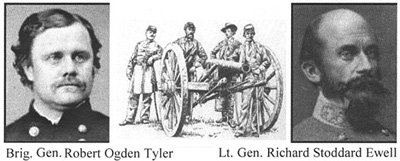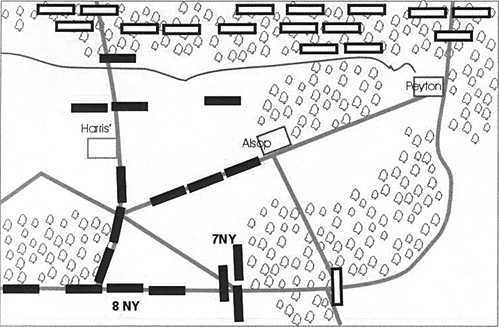 How many times do you play a scenario or battle where you are faced with difficult choices right from the start, and then end the affair wishing that you had done something else, and you are now eager to go through the whole thing again? Well, the Harris' Farm scenario by Paul Stevenson is just such an engagement, as there are a myriad of choices for the commanders on both sides.
How many times do you play a scenario or battle where you are faced with difficult choices right from the start, and then end the affair wishing that you had done something else, and you are now eager to go through the whole thing again? Well, the Harris' Farm scenario by Paul Stevenson is just such an engagement, as there are a myriad of choices for the commanders on both sides.
The scenario involves an action late in the Civil War when the Confederate forces were well experienced but lacking in numbers, and the Federals were also having trouble filling their gaps. Grant had ordered the use of Heavy Artillery regiments that, until then, had been far behind the front lines, safeguarding the nation's capitol and other defenses. No longer requiring these large regiments in these rear positions, Grant enlisted them as infantry. The upshot is that these new `regiments,' when they get to the front, had a complement similar to that of a veteran brigade of four or five regiments. They were keen, but inexperienced. On May 19, 1864, the "heavies" saw action near the Clement Harris farm in Virginia.
Stevenson's scenario looks at the wide differential between the opposing sides at Harris' Farm. The Confederates are mainly elite troops under superior commanders, allowing even small units to absorb a lot of punishment while still remaining an effective fighting force. The Yankees, on the other hand, are green and are kept short of officers in order to simulate the difficulty of handling such huge formations. The officers that are deployed on the tabletop classified as "poor" leaders, adding no morale benefits, hindering their usefulness. To further complicate matters, the Heavy Artillery regiments are broken into separate battalions to be more manageable. Paul has also introduced a house rule that increases the chance that Union forces will fire at their own men, seemingly a problem with these green recruits. A Herculean task therefore awaits the Union commander, but it's also no picnic for the Rebel player.
The first time I played this game, we used the scenario as it was written, apart from disagreeing with the increased tendency for the Federals to fire into their own men, so this was left out. The game was excellent and hard fought, with the Federals almost being destroyed in the opening moves due to a surprise Rebel assault and a serious failure of morale. They recovered as the Confederates ran out of steam, and as neither of us could attain the victory conditions, we declared a draw.
For the second game, now against a more experienced Confederate commander, we allowed the Federal officers to give two orders (which is the usual amount we permit for poor commanders). This was still restricting, but it was more realistic than one order per commander. We also changed the commander of the only unit that was not Heavy Artillery and allowed him to be "average" in ability. There didn't seem to be any real reason why this particular officer should be penalized in the same way as the artillerymen, considering that his brigade was average. We did reintroduce the heavy "fire on own troops' penalty, however. We also changed the victory conditions - whichever side controlled the three farms at the end of the twelve turns would win.
Having looked at the Rebel deployment, I decided this time to set up a line of defense on the Harris Farm ridge and extend it to cover the neighboring Alsop's Farm. The way the Union sets up, this should not present any problems, and should be easily carried out. The deployed 7`h New York would make for Alsop's Farm and protect my right flank; meanwhile, I would send the newly arriving 8th New York along the main road to strike at the Peyton Farm. My good quality reinforcements would hopefully turn up on time and form up on my left flank, with a view of advancing against the enemy when the time was right, or of simply reinforcing the line of battle. Hopefully, this would leave me in command of all three objectives and give me victory
As the battle commenced, I lost the forward battalion due to it being mauled by overwhelming numbers, and the fact that I forgot to give it an order during turn two. I recovered from this disaster by a successful charge along the road catching the disengaging Confederate skirmishers completely by surprise. This was a big relief as I didn't want to peel off one or two large battalions to confront a mere 100man unit. By turn four, it was obvious that my opponent, Mark, had decided to use firepower to wear me down rather than aggressive charges to overwhelm me. He also didn't take much care to protect his own flanks. The Independent Maryland Brigade had arrived on time, and it was sent to my left where, due to his lack of aggression, I had decided to turn Mark's right. On my right, things were looking even better, as my advancing regiments slowly covered the yawning gaps.
The Confederates in the center between Harris' and Alsop's farms were causing large gaps to appear in the battalions opposite them, but due to the terrain, a large proportion of my line were safely tucked away on reverse slopes. The presence of Union artillery, as always, had a sobering effect on the Rebs, and stopped them from any attempt at turning my left. Considering that my men were green and without any supporting benefit from my hard-pressed officers, they held on remarkably well as the bodies piled up around them. My pincer movement now got off the ground. Unfortunately, just as I had the Rebel right in the palm of my hand, the dreaded `snake eyes' hit me. Two units sitting on the Confederate flank, fresh and ready to fire, decided to bolt for the rear. On the other flank, deadly Rebel volleys from small but elite units were knocking out the flanking battalions of the 8`h New York. Despite all this, I felt that the battle was going my way. As usual, it was an idea thought too soon. As time began to run out, we both made desperate efforts on our right flanks. Mark took Harris' Farm as my carefully nurtured defense collapsed and I captured Peyton's. In the center, it was anyone's game, although I would have naturally said it was mine. However, time was up and, as both sides had been reduced to a shadow of their former selves, a draw was declared.
Once again the scenario had lived up to expectations. When I get around to another fight next month, I will have someone else up for Harris' Farm. My son (the first Rebel Commander) wants another game sometime for `revenge,' and I want a chance to command the Rebs. So, we obtained a lot of mileage from an excellent piece of work by Paul Stevenson.

Back to Table of Contents -- Charge! # 5
Back to Charge! List of Issues
Back to MagWeb Master Magazine List
© Copyright 2004 by Scott Mingus.
This article appears in MagWeb.com (Magazine Web) on the Internet World Wide Web.
Other articles from military history and related magazines are available at http://www.magweb.com